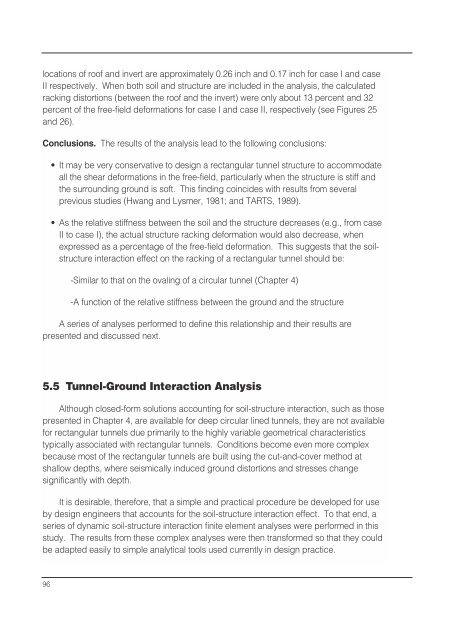Seismic Design of Tunnels - Parsons Brinckerhoff
Seismic Design of Tunnels - Parsons Brinckerhoff
Seismic Design of Tunnels - Parsons Brinckerhoff
Create successful ePaper yourself
Turn your PDF publications into a flip-book with our unique Google optimized e-Paper software.
locations <strong>of</strong> ro<strong>of</strong> and invert are approximately 0.26 inch and 0.17 inch for case I and case<br />
II respectively. When both soil and structure are included in the analysis, the calculated<br />
racking distortions (between the ro<strong>of</strong> and the invert) were only about 13 percent and 32<br />
percent <strong>of</strong> the free-field deformations for case I and case II, respectively (see Figures 25<br />
and 26).<br />
Conclusions. The results <strong>of</strong> the analysis lead to the following conclusions:<br />
• It may be very conservative to design a rectangular tunnel structure to accommodate<br />
all the shear deformations in the free-field, particularly when the structure is stiff and<br />
the surrounding ground is s<strong>of</strong>t. This finding coincides with results from several<br />
previous studies (Hwang and Lysmer, 1981; and TARTS, 1989).<br />
• As the relative stiffness between the soil and the structure decreases (e.g., from case<br />
II to case I), the actual structure racking deformation would also decrease, when<br />
expressed as a percentage <strong>of</strong> the free-field deformation. This suggests that the soilstructure<br />
interaction effect on the racking <strong>of</strong> a rectangular tunnel should be:<br />
-Similar to that on the ovaling <strong>of</strong> a circular tunnel (Chapter 4)<br />
-A function <strong>of</strong> the relative stiffness between the ground and the structure<br />
A series <strong>of</strong> analyses performed to define this relationship and their results are<br />
presented and discussed next.<br />
5.5 Tunnel-Ground Interaction Analysis<br />
Although closed-form solutions accounting for soil-structure interaction, such as those<br />
presented in Chapter 4, are available for deep circular lined tunnels, they are not available<br />
for rectangular tunnels due primarily to the highly variable geometrical characteristics<br />
typically associated with rectangular tunnels. Conditions become even more complex<br />
because most <strong>of</strong> the rectangular tunnels are built using the cut-and-cover method at<br />
shallow depths, where seismically induced ground distortions and stresses change<br />
significantly with depth.<br />
It is desirable, therefore, that a simple and practical procedure be developed for use<br />
by design engineers that accounts for the soil-structure interaction effect. To that end, a<br />
series <strong>of</strong> dynamic soil-structure interaction finite element analyses were performed in this<br />
study. The results from these complex analyses were then transformed so that they could<br />
be adapted easily to simple analytical tools used currently in design practice.<br />
96
















